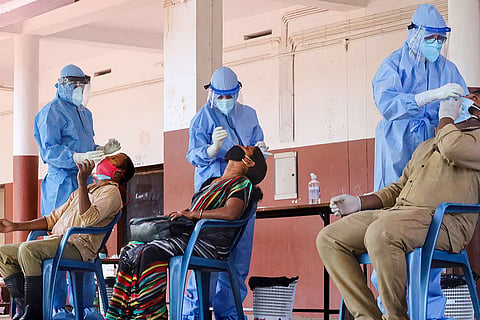

By the second week of May, when the Vande Bharat Mission to bring back Indians stranded abroad began, Kerala started seeing a rise in the number of COVID-19 cases. In June, the state health officials said they were doing enough tests to keep the test positivity rate (TPR) — the number of samples that test positive among a group of samples — below 2%, thereby, preventing a community spread.
Even by mid-June, when the number of COVID-19 cases via contact overshot the cases via import, the TPR continued to remain between 2.33% and 2.66% until July 7. Over a month later, in early August, Kerala saw its test positivity rate climb to nearly 5%.
Here is a short explainer on what is test positivity rate, what does it say about the testing adequacy of Kerala and why is it important in the fight against COVID-19.
The positivity rate on tests is the percentage of tests that return positive, among a group of people. For example, if 100 individuals, who are suspected to have contracted the virus, are tested and only two persons test positive, then the test positivity rate is about 2%.
Kerala’s cumulative positivity rate is 3.57% as of August 4. In comparison, the neighbouring state of Tamil Nadu, which has the third-highest number of COVID-19 cases in the country (over two lakh), had the highest positivity rate in late June, at over 20%. As of August 4, the state's TPR is down to 9.28%.
And although Kerala’s cumulative TPR is less than 4%, a look at the state’s week-on-week positivity rate shows a gradual increase.
Graph by Dr Arun NM, who has been tracking Kerala's testing strategies
In the first week of July, an average number of 37 tests were done to get one positive and the TPR for that week stood at 2.66%. This means that for every 37.6 tests, one person tested positive for coronavirus.
In the second week of July, when the local transmission was suspected, the TPR was at 3.44% for an average of 29 tests. This rose to 4.28% in the third week of July and further to 4.88% in the last week of July. This means that the test positivity rate in Kerala rose by 2 percentage points (July 1 to July 21) in 14 days.
On August 4, Kerala reported 1,083 new COVID-19 cases, while the daily test positivity rate was at 4.38%. Between July 29 and August 4, the weekly TPR stands at 4.72%, inching towards the 5% mark.
“The cumulative TPR is much less because the state did not have community transmission from March to May. What is important is the stage of the epidemic at present, not in the past,” explained Dr Arun NM, an internal medicine expert, who has also been analysing the testing strategies of the state.
According to experts, a growing TPR indicates that the disease is more prevalent in society. “This means that the state is testing or focussing only on symptomatic persons, and in the process, is likely to miss mildly symptomatic and asymptomatic persons. For every symptomatic patient, there will be 10 asymptomatic patients, who can also spread the disease,” said Dr Padmanabha Shenoy, an immunologist and rheumatologist, who has been closely monitoring the positivity rate in Kerala.
A rise in TPR also means there is a lot of community transmission, said Dr Arun. “Kerala has to bring the TPR down to 2%, for which the number of tests needs to be doubled. Reducing it to 2% means that the state is doing a lot of tests and all positive cases are detected and patients are isolated accordingly,” he said.
“Of course, Kerala is testing a lot of patients with and without symptoms, but it has not been testing as widely as it used to,” pointed out Dr Padmanabha, adding, “If the test positive rate is below 2%, it means that we are ahead of the virus and controlling the disease.”
In March, the World Health Organisation recommended the governments to keep the TPR at 5% or below at least for 14 days before reopening.